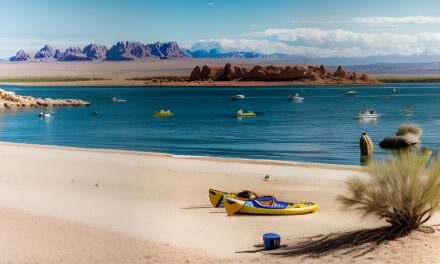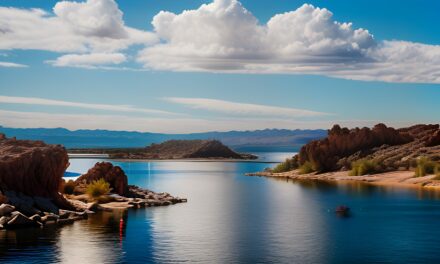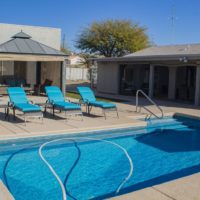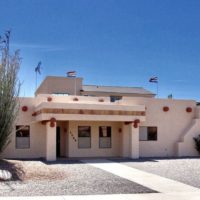 These are difficult times,
These are difficult times,especially if you live in East Texas. It’s hard to imagine that many of
our neighbors are still trying to recover from the effects of Hurricane
Rita, or that local politics has become a circus, and that Toledo Bend
Lake, the jewel of East Texas, is more than 10-feet low – and still
falling.
– Lake Havasu
retired and moved to Toledo Bend. It was one of the happiest times of
our lives. Like many other retirees, we invested our money into lakefront
property, built a floating dock for our pontoon boat and proudly showed
off the many wonderful things that Toledo Bend has to offer to visiting
friends and relatives. Our beautiful cove is now dry and parched, our
dock is sitting on the ground and visiting grandchildren have memories
of a mud hole rather than a swimming hole.
 What a sad state of
What a sad state ofaffairs. This beautiful lake that attracted so many people for weekend
trips, vacations, and retirement, is now a pitiful sight that breaks
the hearts of residents and the pocketbooks of local businesses. As the
lake level continues to drop we see less and less traffic, so local
businesses are finding it tougher to make ends meet. In past years
fishing tournaments added many dollars to our local economy, but now
the lack of usable launching facilities and hazardous boating
conditions have forced these groups to spend their money elsewhere.
Fishing
tournaments are big business, just ask Del Rio. A Texas A&M study
revealed that bass anglers spend $1.6 million annually just to fish
Lake Amistad, fueling a $32 million economic boom for the Del Rio area
alone. With continued low water conditions Toledo Bend will no longer
be an attraction for bass tournaments, visitors, businesses or growth.
Our overall economy will continue to deteriorate and For Sale signs
will start showing up as disappointed residents head for a more stable
environment to call home. So what is the answer?
Well I don’t have a crystal ball but can mention a few items that may need to be revisited.
Generating Electricity
– I understand the fact that SRA is committed by contract (dated Feb 1,
1964 through April 30, 2018) to deliver 65,700 mega watt hours of
electricity between May 1 and Sept 30th.. “Power Pool is defined as
162.2 ft mean sea level (msl) to 172 ft. msl.
The contract specifies that SRA must generate until one of the following conditions occurs:
1. They have delivered 65,700 mega watt hours of “peaking power”,
2. The reservoir elevation reaches 162.2 msl, or
3. October 1
The
contract provides for additional generating only when the reservoir
elevation is above 168 ft msl for the months of Oct through December.
To generate during the month of January the elevation has to be at or
above 168.5; 169 for Feb, and so on .. The intent is to be as close to
172’ msl (normal pool) as possible when they start each years
generating schedule.
The only exception to the previous
guidelines for generating outside the 5-months of May-Sept is to
maintain downstream flows for environmental, industrial and consumptive
water needs below the dam.
I realize that much discussion has
taken place on this issue; however, I would hope that we are not at a
point in negotiations where nothing can be done to a 1964 contract that
might better define operating procedures during severe drought
conditions. But since this ruling is backed by the decision of a
Federal Judge, it would seem that this would be a tough plan to change.
SRA/TX is only the manager of the contract so throwing rocks at
them doesn’t do much good. However, managing the contract could mean
deferring power production during the month of May and June (probably
low demand for electricity months), to ensure that a greater amount of
water would be available in July, August and September. This was a
recommendation made to SRA during the Simulation #6 of the Brown and
Root Operating Guide Re-Evaluation Study dated July 1998. This sounds
like smart business and would certainly (1) benefit anglers, and fish,
since the lake would not be falling during the spawning season, (2)
insure recreational activities and business sales during the Memorial
Day holiday, (3) Assure that adequate water is available for fire
fighting efforts and municipal drinking water systems, and (4) better
prepare the lake for the possibility of yet another summer that could
produce a minimal amount of rain. However, SRA advised me that
operating under any of the proposed seven scenarios would be performing
outside the original Power Sales Agreement.
The studies were a
result of Bi-State Alliance requesting that the lake level not go below
168’msl. SRA/LA and SRA/TX both participated in the study and
approximately $393,000 was spent on the study and legal fees. All was
abandoned since no mutual agreement could be met. SRA stated that they
were not surprised that the FERC concluded that SRA was operating
properly.
Keep in mind that the power companies basically
financed construction of the dam by agreeing to the current contract
requirements and guidelines. You might pose the question – Is revenue
and an aggressive generating schedule more important than losing
residents, visitors and businesses? At this point the answer is that
the contract is in place to provide electricity to customers and
legally the contract will be adhered to. Like all of us, I would like
the water and the electricity.
Energy companies pay $21 per
mega watt now and if they had to purchase the electricity on the spot
market it would run about $50 per mega watt. For those of you
wondering, power generated cannot be put into “reserve storage”.
So
what about catching the water after it has cleared the generators and
pumping it back into the lake – Recycle the water? According to SRA/TX
this would be an expensive direction to go since an elaborate holding
and pumping system would need to be in place. Perhaps some type of
government grant could be obtained to help in the over-all project?
SRA/TX
gets 2.1-cents per kilowatt-hour for electricity sold. The national
average is about 5-cents. Revenue from generating will vary from year
to year, but revenue will usually range from one to three million
dollars per year. Last year the revenue received by SRA/TX for
generating electricity was considered low (in the one million dollar
range). During one of the wettest years the revenue could probably be
in the five to six million range. Louisiana and Texas split this
revenue 50-50.
I was told by SRA/TX that last year they didn’t
cover expenses with just the electrical revenue from Toledo Bend.
Revenue in the two million dollar range is probably the optimum amount
required to meet all expenses. Approximately 1/3 of the money received
goes to paying off current bonds, 1/3 to operating expenses and 1/3 to
overhead and salaries. The original 1964 bonds have been retired;
however, SRA has bonds of $5-million and $10-million that will be paid
off in the year 2009. These are referred to as “Completion Bonds”. They
were basically put into place to satisfy certain changes, adds, etc.,
that occurred toward the end of the period when payment for the
original $60-million bonds took place.
Electricity generated
from Toledo Bend actually goes 50% to Louisiana and 50% to Energy
Texas. Once it hits the grid I am not sure where it winds up. As most
people know, Deep East Texas supplies Sabine County with electricity. .
So how low can you really go and still generate electricity?
The answer is about the 160’msl (plus or minus). If the lake level
during the month of November is at say 169’msl, the existing contract
provides that more generating could occur. However, once the lake gets
back down to 168’msl the generating would cease.
Minimum Lake Level
– In 2003 SRA/LA proposed maintaining a minimum lake level of 168’ msl.
The current terms of the contract that originated Feb 1, 1964 and
expire on April 30, 2018 will not allow the 168’ msl to take place. SRA
Louisiana was also advised that it did not have the authority to make
such changes without the consent of SRA /TX.
If the contract
agreements with Cleco and Entergy are not met due to keeping the lake
at say 168’msl, both SRA’s could possibly be
(1) required to compensate the power companies for the reduction of power or the reduction in value of such power;
(2)
there could be a possible violation of the Indenture of Trust if an
operating guide change does not supply sufficient revenues to service
the Bonds; and
(3) any action voted on could lead to potential lawsuits by the power companies
Establishing
a minimum lake level could also increase potential liability for
downstream flooding. While all of the above may be true, sitting behind
these words and letting property values plunge, business owners go
belly-up and creating economic chaos in our area is certainly not the
answer either.
Rain Statistics –
Lake impounded in 1968
1988 area received only 40.73 inches of rain
2004 received 68 inches of rain (37 year average is 55.3 inches per year)
2005 received 42 inches of rain – 2nd driest ever
Hemphill
and a few other areas get their water from Toledo Bend. Hemphill
actually has their pump station at Hwy 3121 in Palo Gaucho Creek and is
in the process of extending into deeper water due to the problems
created by low water conditions. The city of Hemphill applied for an
Urgent Need grant thru the federal agency Office of Rural Community
Affairs (ORCA) and also a $10,000 grant thru SRA.
Downstream Flows
– A side note is the issue of maintaining required downstream flows and
passing that water without creating a flood situation. A Federal
requirement for Toledo Bend generator licensing and operation is that
144 cfs of water must be passed downstream (A cubic foot of water
equals 7.48 gallons). This figure can at times increase based on
“leakage” that passes through the other units. If you look at SRA’s
web-site you will see a figure representing the “Current Waterflow”. On
the day I put this article together it was 174 cfs. If you do your math
you will find that this is 15,033,600 cf in a 24-hour period. That is a
bunch of water.
In 2002 The Court of Appeals rendered a
verdict that reversed a 2001 judgment entered against SRA/TX on a claim
of Inverse Condemnation. They had filed suit that SRA had taken their
land when flood waters covered their property in Jan 1999. Judge Bob
Golden of Newton County found in favor of the plaintiffs and found that
the release of water from TB constituted the “taking of property”.
SRA/TX appealed the decision citing that (1) Max flow into the
reservoir during this period was 385,000 cubic feet per second (cfs),
while outflow was only 117,644 cfs. Therefore the SRA was never
releasing more water than was entering the reservoir via rainfall. (2)
The water being released was not flowing directly onto the property
owners land but into the Sabine River and mixed with waters from Toro
Bayou, running out of Louisiana into the Sabine before overflowing the
banks of the Sabine River causing flooding.
The court found in
favor of SRA/TX and the two items above negated the “taking” element in
the claim. There is still a pending lawsuit in Louisiana where a death
was involved. A spokesperson for SRA/TX stated, “Areas adjacent to
rivers are tempting sites for homes because of the beautiful view and
easy access to water recreation. People should continue to evaluate the
hazards of living in these low lying areas where rivers can cause
flooding whether they are near a reservoir or not”.
Current Status
– SRA/TX received a grant from FEMA to purchase downstream land from
people that have structures in Newton County, and who are willing to
sell. They will continue trying to do this in other areas to reduce the
flooding and possible liability issues.
Selling Water – Selling a controlled amount
of water to the Dallas area would certainly seem like a favorable
solution since the revenue generated would far exceed the current
revenue received for producing electricity. At this time no contract
has been developed for selling water from Toledo Bend and transporting
it to the Dallas area. This means that all of the rumors of pipelines
being built or pipelines that are already in place are just that –
rumors. There may be an agreement in place by 2013-2018, but right-of
ways and many other issues have not been addressed. However, if the
drought conditions continue you can expect to see this timeframe
escalate.
Upper Dallas, North Texas Municipal Water District
and Forth Worth (Tarrant County) are all players since in their
long-range planning each have defined additional water needs for the
next 20-30 year timeframe. If water is sold from Toledo Bend it is
assumed that Louisiana will also participate in the process. Houston is
not a player at this point, but if water is delivered from Toledo Bend
to Dallas and then placed back into the Trinity River Basin
(inter-basin transfer), certain compensation such as funding, grants,
etc., could be given back to SRA/TX and SRA/LA.
**************************
Based
on other agreements already in place, one might anticipate that a sell
of water from Toledo Bend to Dallas would be entered into with
conditions such as:
No water rights will be sold
Long term water supply needs of the Basin are met
Basin of origin is adequately compensated for any sale of the water
Consideration
is given to the bays and estuaries and in stream flow requirements
balancing environmental flow needs with future water supply needs
Contract
provisions are included for out of Basin customers to return or replace
water supplies should water requirements of the Basin change
Contract provisions will include a drought contingency plan, which will curtail any withdrawal during drought conditions
As
I mention previously, SRA/TX does not currently have enough right of
way purchased to lay the pipeline. If and when the appropriate land is
acquired, the pipeline would be in the upper part of lake located
somewhere in deep water near the old river channel.
It’s hard
to work numbers when an agreement is not in place; however, each acre
foot represents about 325,000 gallons of water. Statistics presented
during the spring of this year show that the lake at full pool has
185,000 surface acres and a controlled storage capacity of 4,477,000
acre-feet (1,448,934,927,000 gallons).
-Power generating uses
about 14,500 cubic feet of water per second. The rate received is
2.1-cents per kilowatt-hour. To satisfy the current contract would
require approximately 1,050,000 acre feet of water or approximately 5’
of elevation.
-Supplying water would cost SRA approximately
1/3-cent per 1000 gallons. The water could then be sold at market rates
of from 5- to 10-cents per 1000 gallons.
******Extremely Important Dates
2008 SRA needs to re-license the generators
2013
the current license expires During this time, SRA/TX will conduct
interviews, public meetings, workshops, etc. soliciting ideas for all
issues. The future contract will be formed from this input. . Energy
companies will be involved. Raising rates and discussing a more
favorable generating schedule for all parties will also be discussed.
Odds are that SRA will apply for the re-licensing of the generators.
However, if they decide not to re-license, then in theory any company
could apply.
2015 – SRA must declare if it will not extend the contract to Energy companies.
2018 – The present generating schedule will expire
No Representation
– I don’t know how many times I have heard the comment that we have no
representation on the SRA Board of Directors. That is true if you are
looking for a resident of Sabine County as one of the current Board
members because there are none.
The SRA was created by the Texas
legislature in 1949 and is a quasi-state agency of the State of Texas.
SRA-TX was created as a conservation and reclamation district with
responsibilities to manage, preserve and distribute waters of the
Sabine River and its tributary streams for useful purposes. The Sabine
River
Authority is governed by a 9-member Board of Directors. Each
member serves a 6-year term. The Governor of Texas appoints three board
members every two years. Directors are required to reside within a county situated wholly or partially within the watershed of the Sabine River.
The following are current board members:
President – Sammy D, Dance – Center, Texas
Vice-President – Connie Ware – Marshall, Texas
Secretary/Treasurer – J.D. Jacobs Jr. – Rockwall, Texas
Secretary Pro-Tem – Connie Wade – Longview, Texas
Board Member – Claudia J. Abney – Marshall, Texas
Board Member – Earl Williams – Orange, Texas
Board Member – Don O. Covington – Orange, Texas
Board Member – Richard A. Linkenauger – Greenville, Texas
Board Member – Stanley N. Mathews – Pinehurst, Texas
According to SRA, past members from Sabine County included John Henry Minton, Charley Rice, Earl Lord and L.E. Davis.
If
you are interested in being a member of the SRA Board the process to
follow would be to obtain an application from the Texas Government
Appointment Office, fill it out properly, and then have it ratified by
the Senate before the Governor makes the appointment. During a normal
year the Governor make approximately 3000 appointments.
Leaseback Issue
– By now most of you have probably received your invoice from SRA for
leaseback payment. The state owns the lake and a certain amount of land
surrounding. Lake level for normal pool is 172’ msl and is referred to
as the Power Pool Line. From this point the state also owns another
portion of the land up to the “Project Boundary Line”. This line is at
175’ msl and a minimum of 50’ horizontally from the 172 msl. The use of
this land is permitted to the owners of the land that adjoins it toward
the water and is referred to as a leaseback because it is literally
leased back from the state (usually for 99 years) . No living
structures may be built on the leaseback but docks and piers and boat
houses are permitted.
Approximately $145,000 comes into SRA/TX
from leaseback and $20,000 from commercial Breeders. This money is
allocated to four areas: (1) Fisheries Management,
(2) Parks and
Recreation, (3) Extending boat ramps and (4) Buoy maintenance and
replacement. SRA/TX spends $700,000 within these four items so this
area is basically $535,000 in the red.
There are approximately
2200 private limited usage permits on the Texas side of Toledo Bend,
with most running in the $50-$60 range. Quite a bit of shoreline on the
Texas side is Forest Service land.
Bi-State Alliance
– Bi-State Alliance has been asking for donations to continue legal
advice on alternatives for addressing the low water conditions. The
Alliance statement of fact is that the waters in Toledo Bend belong to
the citizens of Texas and Louisiana and that SRA/TX in concert with
Entergy and Cleco power companies seem to think that they own the
Sabine River and do not have to report to anyone. Their document, which
was recently forwarded to all Sabinenet.com customers, also states that
SRA/TX has refused to work with them to develop a mutually agreeable
solution to the lake level problem and refuse to allow any concessions
on the Leaseback payments. SRA/TX response is that they had been
working with this group since 1995.
A class action lawsuit
could certainly be in the making, but based on hard directives from a
Federal Judge, it would seem that the 1964-2018 contract between SRA/TX
(manager of the contract and recipient of revenue) and the electrical
companies (purchase electricity at a very low rate and then sell it to
customers) would have to be honored. I understand and sympathize with
statements from the Bi-State Alliance, however, legally this may be a
very tough road.
Additional Questions:
Are there any plans to do any dredging/extending key launching areas?
SRA/TX told me that even as we talk they are extending SRA Site 7 near
the dam. They are looking at possibly removing sand bars and humps at
the Indian Mounds launching area, SRA Site 1 and possibly the 6-Mile
launching area. SRA/TX has a track hoe with a 60’ boom that they are
using to work from the bank. They have however discussed additional
heavy-duty dredging with a contractor that works issues of this type in
the Toledo Bend area.
What happens if tomorrow we
were to have another natural disaster (like a hurricane) and it
requires us to provide emergency power? With the lake this low could we
supply the power? SRA’s response is that we probably could not.
Is SRA still monitoring buoys on the lake for position?
This is a tough issue to keep up with since the buoys can change
positions in a very negative way when a lake is 10-feet low as we are
today. Best advice for everyone is to be very careful when motoring on the lake.
What happens if we get to the point where there are no usable launching facilities?
SRA/TX comment to this is that regardless of the lake level they will
try to maintain launches at the upper, middle and lower end of the
lake.
Silting – This is a “down the
road” issue that will probably have to be addressed. Through the years
Toledo Bend Reservoir (like all other reservoirs in our state) has a
certain amount of “silting in” that has taken place. The 172’ msl
remains the same but the bottom in the lake is not as deep as it once
was due to the silting effect. That means that there is probably not as
much “yield” of water available in the lake like when it was created.
This is a BIG project to undertake since the original data was hand
compiled from USGS topographical sheets. To get statistics today would
involve gathering datum points by boat using sonar, etc.
Texas Water Development Board did some studies and Lake Fork had lost about 5% yield and Lake Tawakoni about 4%.
This
is an issue where a big expenditure may occur for a study that may tell
you that the lake has lost 3-4% yield. Is the answer worth the cost
involved? I don’t know but SRA is looking at the issue.
What is relationship of SRA TX and SRA Louisiana? Managers and two representatives from each group meet quarterly.
**********************************************************************
So
here we are. The optimists say that rain will come tomorrow to fill up
the lake and the pessimists say that the drought will continue for
years. Let’s hope that the moisture will come soon.
However,
with continued low water conditions Toledo Bend will no longer be an
attraction for future businesses, visitors or retirees. This will
affect the tax base and definitely have a negative effect to our
overall economy. Forget future bass tournaments because they are
setting their tournament dates months ahead of time and don’t want to
run the risk of injury or damage to their people or boats. Families
planning vacations will go elsewhere.
What kind of madness
would allow a beautiful lake like Toledo Bend to be reduced to a mud
hole. I know that the people monitoring, operating and controlling
these resources are smart folks so what went wrong? The drought is
certainly an easy answer, however, the problem was there before the
muddy hand of the drought slapped us in the face.
The rules and regulations for SRA/TX state that to the best of their ability they will:
#1
– Insure the quality and quantity of the waters impounded in Toledo
Bend Reservoir for its main purpose.. Water supply and generating of
hydroelectric power
#2 – Insure maximum recreation benefits
to, and development of, recreational facilities for all residents and
visitors…. How can this happen when the lake is 10+ feet low? ..and
#3 – Protect life and property.
Somewhere
buried in all this is an ethical issue. It is an unwritten contract
between all parties that the water resource will be properly managed,
and that a sufficient supply will be available to support recreation,
property investments and the economics to support surrounding
businesses.
It’s hard to put a monetary value on memories,
but
the ones being created in today’s environment are not those that you
would like to revisit. Docks sitting pitifully on dry ground, boats
landlocked and muddy ridges with exposed stumps and trees offer nothing
to put into the photo book. How sad it is to see young children who
are visiting relatives and friends go running down the banks to what
used to be their favorite swimming or fishing hole only to find parched
land, weeds and mud. What a shame!
We vote responsible people
into office to make responsible decisions. As a retiree and resident of
Sabine county I pray that some of these decisions can create a win-win
situation for us all. JB
– Lake Havasu












